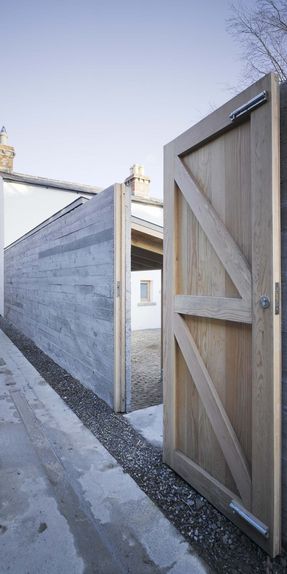
Laneway Wall Garden House
LANEWAY WALL GARDEN HOUSE
MANUFACTURERS
Kingspan Insulated Panels, GRACE, Auro, Cabot Stain, Gyproc, Proctor Group Australia, ROCKWOOL, Thoro Consumer Products, VMZINC
YEAR
2011
LOCATION
Dublin, Ireland
CATEGORY
Refurbishment
The project was to provide new kitchen, living and bedroom to this 19th century split level terraced Dublin house.
This was achieved by stripping away previous extraneous extensions, recasting the boundary retaining wall to the rear laneway and reinstating familiar domestic forms of lean-to and covered yard accommodation arranged around a courtyard garden. The walls provide direct support for two roof elements which define the courtyard.
Their lower edges rest on and are connected by a timber box-beam doubling as valley gutter that collects all rainwater from the rear of the house and diverts it to a cast concrete cistern.
Bricks from the enlarged opening in the back wall are used to pave the two connected yards.
The design aims to exploit the ‘borrowed landscape’ of domestic backlands with its network of returns, back yards, outhouses, garden walls and rights of way.
The scale of garden wall and lean-to roof is used to connect and mediate between private house, urban courtyard garden and common back lane, using unadorned construction and a palette of carefully chosen materials.
The boundary wall of cast-insitu boardmarked concrete encloses and defines the garden and back yard as well as presenting a new elevation to the semi-private world of narrow rear and side lanes.
This presents an unadorned material to this ambiguous urban territory that is self-finished and robust; and at close contact traces a detailed memory of the sawn Douglas Fir boards used as formwork in its casting.
This same grain is mirrored in roof structure, ceiling boards, kitchen cabinets, window seat and external joinery, which are all in Douglas Fir.
The richness of the untreated wood will eventually mute to become more like the light-coloured concrete and the zinc roof covering- the palette becoming more even with weathering.
The concrete walls and the timber structure will not need painting (and therefore maintenance), but will take on the life of the lane and garden allowing lichens and moss to inhabit their textured surface.
Internally the boundary wall is lined with insulation and an internal masonry wall where it encompasses the kitchen and garden bedroom/study. An insulated, heated concrete screed is polished to create a reflective yet warm floor surface adjacent to the courtyard, stepping up to create a plinth on which kitchen cabinets sit.
GGBS replaces 50% of cement in concrete throughout. The span of the box beam with alternating roof planes draws together garden, house and lane with a new enclosing wall.














